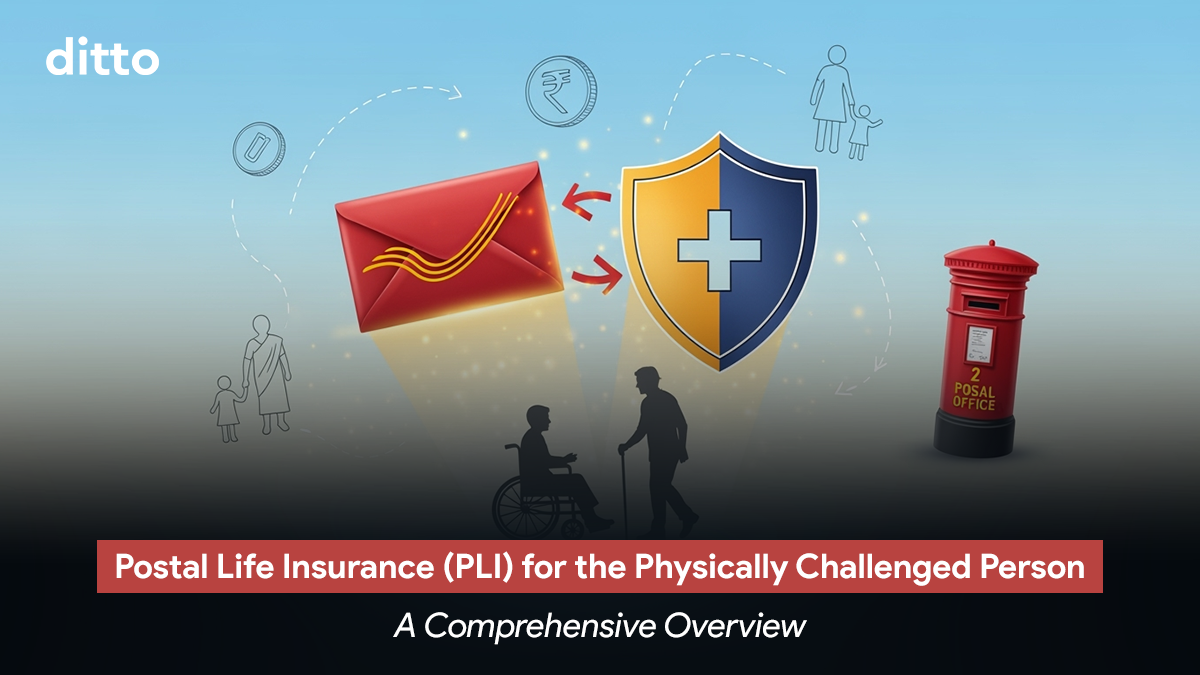| What is Postal Life Insurance (PLI) for the Physically Challenged Person? Postal Life Insurance (PLI) for the physically challenged person is a government-backed life insurance scheme in India. It is specifically for individuals with eligible physical disabilities and offers affordable premiums, guaranteed returns, and coverage amounts based on the degree of handicap. PLI was started in 1884 as a welfare measure for the employees of the postal and telegraph departments under the Government of India. Now, the insurance is open for employees of all central and state government departments, nationalized banks, public sector undertakings, financial Institutions, local bodies like municipalities and Zila Parishads, and educational institutions aided by the Government. |
Established on 1 February 1884, PLI is India’s oldest government-backed life-insurance scheme. Over the last century, it has offered financial security to millions, but what makes it stand out today is its effort to be inclusive.
In 2025, PLI covers individuals with physical disabilities under a dedicated scheme, which is something not always easy with term insurance offered by private insurers. Backed by the government, PLI keeps premiums affordable while offering a range of plans, making protection more accessible to everyone.
In this guide, we’ve broken down the types, eligibility, medical requirements, and benefits to help you decide whether PLI is the right fit for your financial needs.
Friendly reminder: It’s easy to get lost comparing policies and premiums. Instead of spending hours on it, why not get personalised insurance advice from Ditto? We offer free consultations with zero spam! Just 30 minutes to clarify all your doubts. Book a call now!
Types of Postal Life Insurance (PLI) for the Physically Challenged Person
Postal Life Insurance mainly offers traditional plans like whole-life and endowment, which provide a payout to your nominee if you pass away, or to you if the policy matures. Here are the different types of PLI for the physically challenged persons in India:
- Whole Life Assurance (Suraksha): Covers the insured till age 80, paying the sum assured + bonus on death or at maturity if alive at 80. Premiums are payable only up to a chosen age (55/58/60), after which coverage continues without payment. Loans are available after 4 years and surrender after 3 years. Ideal for leaving a legacy or lifelong cover needs.
- Convertible Whole Life Assurance (Suvidha): Starts as a whole-life plan but can be converted into an endowment after 5 years. Entry age is 19–50 years. Loans and surrender rules are similar to Suraksha.
- Endowment Assurance (Santosh): Provides life cover during the chosen term and pays the sum assured + bonus at maturity if the insured survives. Entry age is 19–55 years, with maturity age set by the policyholder (e.g., age 60). Loans are available after 3 years, and surrender is allowed after 3 years. Suitable for those seeking savings + protection.
- Anticipated Endowment Assurance (Sumangal): A money-back policy with periodic payouts plus full cover throughout. Terms are 15 or 20 years, with 20% payouts at intervals and 40% + bonus at maturity. The death benefit is the full sum assured, regardless of payouts already received. Entry age is 19–45 years (for the 15-year term) and 19–40 years (for the 20-year term).
- Joint Life Assurance (Yugal Suraksha): Designed for married couples, it covers two lives under one policy. The plan pays the sum assured + bonus on the first death, or to both if they survive till maturity. The entry age is 21–45 years, with a policy term of 5–20 years. Yugal Suraksha offers lower premiums compared to two single policies.
- Children’s Policy (Bal Jeevan Bima): Covers up to two children of existing PLI policyholders. Each child can be insured up to ₹3 lakh, or equal to the parent’s sum assured. Eligible child age: 5–20 years, with parents under 45. Premium waiver applies if the parent dies, and the policy continues till maturity with full benefits.
| Did You Know? PLI is exempt under Section 118(c) of the Insurance Act, 1938, and also under Section 44(d) of the LIC Act, 1956. |
Postal Life Insurance (PLI) for the Physically Challenged Person: Eligibility Criteria
PLI eligibility for the physically challenged includes specific medical, demographic, and occupational criteria designed to provide fair coverage. They include:
- Type of Disability:
Applicants must have a qualifying disability, such as deafness, blindness, dumbness, loss of limbs, paralysis, polio-induced deformity, hunchback, dwarfism, or an orthopaedic handicap from a non-neurological origin. - Medical Examination:
A mandatory medical exam at a government-authorized centre is required. The purpose is to assess:- Cause and extent of handicap (congenital or acquired)
- Impact on life expectancy and overall mortality risk
Premiums are determined based on this assessment individually, and if the impairment poses a life-threatening risk, the application may be declined.
- Entry Age:
Minimum age is 19 years; maximum is generally 55 years (or 40 years for money-back Sumangal policy).- Policy Tenure:
Maximum coverage term depends on plan (5–40 years for most; fixed 15/20 years for Sumangal).
- Policy Tenure:
- Sum Assured:
Minimum is ₹20,000; maximum is ₹50 lakh (₹5 lakh for Sumangal policy).
For more details, refer to page 62 of this circular on post insurance life fund rules related to PLI.
- Employment Restrictions:
Originally, PLI was open only to government, semi-government, and institutional employees. However, developments like Rural PLI (RPLI) (1995) have made some PLI policies available to the general rural population.
| Things to Consider: 1) Unlike RPLI, the standard PLI is still tied to employment in eligible organizations. 2) Private sector employees are generally not covered, except in some rare cases where government approval has extended coverage to cooperative bodies or autonomous institutions. 3) PwDs (physically handicapped) are eligible if employed in the above institutions, subject to medical examination and risk assessment (as discussed earlier). For more details, refer to this post office guide. |
Benefits of PLI For The Physically Challenged People
- Affordable Premiums: PLI stands out with its cost-effective premiums, making it a more accessible option compared to many other insurance plans.
- Diverse Policy Options: PLI has multiple policy options to suit different financial goals and needs, irrespective of whether you need whole life assurance or endowment.
- Government Backing: With the support of the Government of India, PLI offers a level of stability and reliability that’s hard to beat.
- Loan Facility: You can take out a loan against your policy after a certain period, adding another layer of financial flexibility.
- Growing Benefits: Policies under PLI help you accumulate bonuses over time to boost your maturity or death benefit as the years go by.
For more details on the bonus benefits, refer to this article on postal life insurance.
PLI for the Physically Challenged: Medical Report Requirements
If you choose the “Scheme for Physically Handicapped,” you must get a special medical exam done by the authorities at a government hospital or approved center. This helps the authorities figure out the type and extent of the handicap and how it might impact the life being insured.
Here’s a quick rundown of what’s included in the exam:
- Extent of Handicap: The examination will include a detailed report on the severity of your handicap, such as the loss or deformity of one or both limbs.
- Cause of Handicap: The report will clarify whether the handicap is congenital (present from birth) or post-congenital (acquired later in life).
- Impact on Longevity: The exam will evaluate how your handicap affects your life expectancy and whether it poses an increasing or decreasing risk.
| Additional Requirements 1) Along with the medical exam, you will be required to provide a diagnosis report from the examining physician. This document outlines your medical history, underlying conditions, and current health status related to the disability. 2) You must also furnish a valid disability certificate issued by a competent government medical board. This certificate mentions the percentage of disability, type of impairment, and is official proof used for processing the PLI proposal. You don’t have to worry about the expenses because the department covers the cost of the medical exam. |
Remember: The outcome of the medical exam may result in standard premium acceptance or a slightly loaded premium, or rejection of the proposal if risk is higher.
PLI vs Standard Term Plan
There are significant differences between postal life insurance (PLI) for the physically challenged persons and standard term plans. Let’s compare their structure, benefits, and suitability for policyholders in this table:
| Feature | Postal Life Insurance (PLI) | Standard Term Insurance Plan |
|---|---|---|
| Provider | Government-run via India Post. | Offered by private and public insurers. |
| Who Can Buy | Primarily government, semi-government employees, now open to all. | All eligible adult Indian citizens. |
| Type of Coverage | Traditional life insurance (whole life, endowment, etc.) | Pure term insurance, which means you get only death benefit within term |
| Premiums | Lower, affordable due to government backing. | Varies, generally low for large cover; based on age, health. |
| Benefits | Death benefit, maturity benefit, surrender/loan options, high bonuses. | Death benefit only; no maturity/surrender/loan value. |
| Returns | Offers guaranteed bonus on maturity/survival or death. | No returns unless “return of premium” add-on chosen. |
| Sum Assured | Up to ₹50 lakh for most plans; bonuses increase corpus. | Typically ₹25 lakh to several crores for basic cover |
| Tenure | Whole life or fixed-term; policy conversion allowed. | Fixed tenure (5–40 years); pure risk cover |
| Loan Facility | Can borrow against policy after minimum years. | No loan facility in pure term plans |
| Flexibility | Policy conversion, surrender, nomination changes permitted. | Limited to plan and insurer's terms |
Bottom Line:
- PLI is ideal for those seeking stable returns, lifelong coverage, and extra financial features (like loans or maturity bonuses).
- Standard term plans are the most affordable way to get a large pure life cover. They focus entirely on family protection in case of untimely death. However, they offer no maturity or survival benefits.
Ditto’s Take: PLI and term insurance serve different purposes: PLI combines lifelong security with savings returns, while term plans offer low-cost, high-cover protection. Choose based on which best aligns with your financial needs.
Why Choose Ditto for Term Insurance
At Ditto, we’ve assisted over 7,00,000 customers with choosing the right health insurance policy. Here’s why customers like Chinmay love us:

✅No-Spam & No Salesmen
✅Rated 4.9/5 on Google Reviews by 15,000+ happy customers
✅Backed by Zerodha
✅Dedicated Claim Support Team
✅100% Free Consultation
You can book a FREE consultation. Slots are running out, so make sure you book a call now!
Key Takeaways
Postal Life Insurance (PLI) is a trusted scheme backed by India Post. It offers life cover with savings benefits for all eligible individuals. But if you have larger financial responsibilities, PLI alone may not provide adequate protection. Here’s what you should consider in this case:
- Term insurance offers higher protection at a lower cost and is strongly recommended if you have financial dependents.
- Use PLI as an additional or fallback option if term insurance is not accessible.
- Always assess your responsibilities (children’s education, parental support, liabilities) before relying solely on PLI.
Still unsure if PLI is the right choice for your insurance needs? WhatsApp us or book a call for further assistance now.
FAQs
Can a person with a physical disability apply for Postal Life Insurance (PLI)?
Yes, a person with a physical disability can apply for Postal Life Insurance under the special “Scheme for Physically Handicapped”. Eligibility is assessed based on the type and extent of disability, along with other standard conditions.
Are medical reports compulsory for physically disabled applicants under PLI?
Yes, medical reports are compulsory for physically disabled applicants to evaluate the severity and cause of disability. The reports include details like diagnosis, disability percentage, and overall health condition to help determine insurability.
Does a physically disabled person need a disability certificate for PLI?
Yes, a valid disability certificate issued by a government medical board is required while applying for PLI. It serves as official proof of the type and percentage of disability.
Who conducts the medical examination for physically disabled applicants under PLI?
The medical examination is conducted by doctors in government hospitals or authorized centers as per PLI guidelines. They assess the extent of disability, its impact on health, and life expectancy to submit reports for approving or declining the insurance proposal.
Last updated on:










